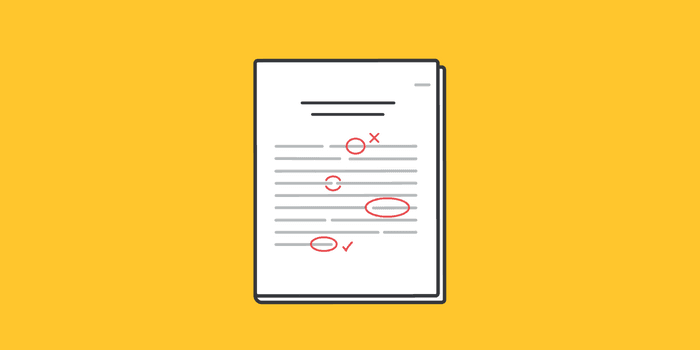
You should proofread any written assignment before you turn it in, but what exactly is proofreading? This post defines proofreading and discusses strategies for making it a success.
What is proofreading?
Proofreading refers to the surface-level evaluation of your paper. When you proofread, you’re determining if your paper has issues like:
- typos
- misspelled words
- punctuation mistakes
- subject-verb agreement issues
- tense inconsistencies
- missing information
- citation errors
- plagiarism
Let’s take a look at a few of these issues in more depth.
Subject-verb agreement
You’ll know that you have subject-verb agreement issues if the subjects of your sentences do not match up with the verbs. For instance, in English, we write “I go to the store,” not “I goes to the store.” In this case, the correct subject should be “he” or “she.”
Tense inconsistencies
Tenses (like past or present tense) in research papers often vary depending on the topic of the paper. For instance, literature papers generally utilize present tense when discussing literary works (even if a work was published many years ago). Papers in other disciplines might rely more on the past tense to address how the research for the paper was conducted.
Most papers will use multiple tenses. The important thing is to be consistent.
Citation errors
Citation mistakes not only negatively impact your grade, but they also may be indications of (even unintentional) plagiarism. To ensure that your citations are accurate, use BibGuru’s citation generator to create your bibliography and in-text citations.
Always ask your instructor if you’re unsure which citation style to use for your paper.
Proofreading vs. revising
Proofreading is not the same as revising. When you revise, you make substantive changes to a written work.
Revising allows you to answer key questions about your work, such as: can your reader clearly follow your argument? Do you provide adequate evidence and analysis to support your thesis? Are the steps to the conclusion clear? Consult our tips for revising a research paper to learn more about revision strategies.
Proofreading tips
Be sure to plan your writing process so that you have time to revise and proofread your paper. Follow these steps to get the most out of proofreading.
1. Take a break before you proofread
You should space out your writing and proofreading so that you can take a break in between. This allows you to approach your paper with fresh eyes. You’ll find more mistakes if you’ve had time to step away from the paper.
2. Read your paper aloud to yourself or others
Reading your paper aloud, either to yourself or to someone else, is one of the best ways to catch errors. If you stumble over a sentence (or your audience looks confused), then you likely need to restructure or rephrase a sentence or paragraph.
3. Participate in peer review
If you are completing a major writing assignment for a class, your instructor will likely build in a peer review session. If not, ask a friend or family member to read over your paper or head to your school’s writing center and make an appointment with a tutor who can help you.
Frequently Asked Questions about what is proofreading
⚽️ What is proofreading and why is it important?
Proofreading refers to the surface-level evaluation of your paper. When you proofread, you are looking for errors like typos, incorrect citations, and grammatical or stylistic mistakes. Proofreading not only improves your grade, it also makes you a better writer.
🏀 What is the difference between proofreading and editing?
Proofreading is the process of reading over your paper to find surface-level mistakes. Editing involves the actual changes that you make as a result of proofreading or revising.
🏈 What are 4 things to look for when proofreading?
The main types of mistakes that you should aim to catch while proofreading are: typos, grammatical errors, citation mistakes, and formatting issues.
⚾️ Is proofreading easy?
The ease of proofreading depends on how well you plan your writing process. You should always take a break between writing and proofreading your paper.
🎾 How do I start proofreading?
Start your proofreading process by consulting any course or assignment guidelines that may provide advice on how to proofread your paper. Then, read over your paper and watch out for mistakes like typos, grammar issues, or citation errors.


